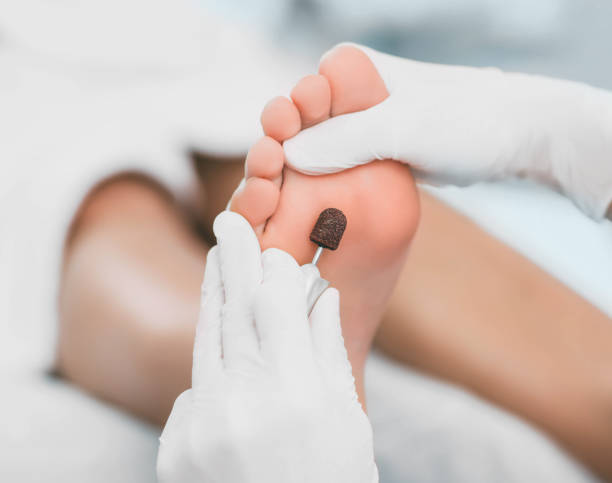
A podiatrist, also called a Doctor of Podiatric Medicine (DPM), is a medical professional who specializes in treating injuries and ailments that affect the foot, ankle and related parts of the leg. They can reset broken bones, prescribe drugs and order X-rays and other tests.
During a visit with a podiatrist, you will learn how to make better choices that will prevent foot problems from developing.
Importance of Proper Footwear: Making the Right Choices
Footwear has a significant impact on orthopaedic health. Shoes that are comfortable, properly fitted and suitable for the activity being undertaken will help to prevent injuries and improve performance. The right footwear can also alleviate pain on the feet, knees, ankles and lower back, making them more comfortable throughout the day.
Proper footwear provides protection for your feet from cuts, scrapes, blisters and cold weather elements. It can also help to prevent overuse injuries such as plantar fasciitis, shin splints and ankle sprains. Proper footwear can also improve your posture by promoting proper foot alignment.
Wearing ill-fitting shoes can lead to pain in the feet, ankles, calves, shins, knees, hips and lower back. Ill-fitting shoes can also make existing problems such as bunions worse. Podia
try Bendigo can provide the best advice about how to choose and fit shoes that will benefit your foot health.
Different activities require specialized footwear to protect the feet and ankles. For example, running puts a tremendous amount of stress on the feet and legs and requires a shoe designed to support the feet and absorb shock. Likewise, walking and tennis require specific types of shoes that allow the feet to move naturally while providing adequate cushioning and support.
A good rule of thumb is to get your feet measured at a reputable shoe store on a regular basis. It’s also a good idea to bring your prescription orthotics (biomechanical inserts prescribed by a podiatrist) with you when buying shoes so that the doctor can ensure that your shoes will be the right size and fit for your feet.
Avoid flip-flops and high heels, which cram the feet into unnatural positions and force the toes into an unnatural angle. Shoes that have adequate arch support and cushioning, and are made from durable materials, are best for keeping your feet healthy. For more information about proper footwear and to schedule a visit with a podiatrist, contact podiatrist White Hills.
Wearing the Right Shoes
If you have a job or are involved in any type of sports that requires you to spend a lot of time on your feet, you need the right footwear for your activity. This includes shoes that fit properly, are made of quality materials and provide adequate cushioning. Wearing the wrong type of shoe can cause you to develop foot conditions and injuries that will require extensive treatment and even surgery.
Podiatrists specialize in treating problems that affect the feet and ankles, including injuries as well as complications from chronic health issues such as diabetes. They are qualified to reset broken bones, perform surgery, prescribe drugs and order lab tests or X-rays. They can also work closely with other medical specialists when a problem involves the feet or lower legs.
In addition to the usual physical exam, podiatrists may perform imaging tests such as X-rays, ultrasound, bone scans and CT scans, as well as blood tests to check for infection and other conditions like rheumatoid arthritis or vascular disease. They can also recommend padding, inserts or orthotics for certain conditions. They can also treat many of these conditions in their offices, using tools like syringes for injections of pain medications and nail anvils to trim ingrown toenails, or scalpels for corns and calluses. They may also use cryotherapy equipment to freeze off plantar warts.
Some of the most common problems that podiatrists treat are bunions, calluses and hammertoes. These are usually the result of long-term rubbing or pressure on the foot, especially when wearing poorly fitting shoes. They can also occur due to arthritic changes in the foot and ankle or as a result of trauma.
A common condition that podiatrists see is neuromas, which are thickenings of nerve tissue that lead to the toes and can be caused by narrow, high-heeled shoes. These can be painful and often cause tingling or burning sensations in the feet. In most cases, the podiatrist will suggest padding or custom orthotics to alleviate the symptoms.
Proper Footwear Maintenance
Footwear is designed to meet mankind’s real and perceived needs: protection, support, comfort, sturdiness, and style. The feet are subject to tremendous pressures during daily activities and are more likely to be injured than any other part of the body, highlighting the need for proper footwear selection.
The human foot is an amazing feat of engineering and can perform a variety of tasks for the body, including supporting the weight of the entire body. The average person walks the equivalent of twice around the world in a lifetime, and this requires shoes that are engineered for maximum performance.
Seeing podiatry Bendigo on a regular basis can help with footwear selection, as well as providing a thorough assessment of the foot and ankle. Other tips include avoiding shoes that are worn out, alternating your footwear to reduce repetitive stress on the feet, and using a moisturizer on the skin to replace lost moisture.
Footwear Tips
Your feet take on the weight of your entire body with every step, so they deserve comfortable shoes that do their job without causing pain. The best way to keep your feet healthy is to visit a podiatrist as soon as you notice any problems. A podiatrist can treat issues such as hammertoes, bunions, ingrown toenails, heel and foot pain, sprains, corns, calluses and fungal nails. They can also recommend stretches and exercises that you can do to improve your foot and ankle health.
Your podiatrist will assess the condition of your feet and lower legs by looking at how you stand, walk and move your foot joints. They will take a complete medical history and check the blood circulation in your feet and lower leg. They can diagnose and prescribe special shoes or inserts, which might help you manage the symptoms of a condition such as arthritis (which causes swelling, inflammation and wear and tear on your 33 foot joints) or overpronation (walking or running with flat feet). A podiatrist can give you shots of steroids to relieve pain caused by Morton’s neuroma (a problem between the third and fourth toe bones that results in burning or a feeling that something is caught in your shoe), and they can advise you on the best footwear for your foot type and lifestyle.
In the past podiatrists were known for telling you to put away your patent leathers and chuck out your dazzling high heels. Today, however, podiatrists are able to connect fashion with function thanks to the development of stylish footwear that supports your feet without sacrificing good looks. Shoes from brands such as the Australian podiatrist-owned Bared Footwear, the British physiotherapist-owned Frankie4 and the Danish ECCO are helping to rewrite the rule book by marrying form and function in shoes that you might actually want to wear.
When shopping for shoes, remember that your feet swell over the day, so it is best to shop at the end of the day. Make sure the shoe gives you a half-inch of space between your longest toe and the edge of the shoe, and that the shoe feels snug and comfortable.





